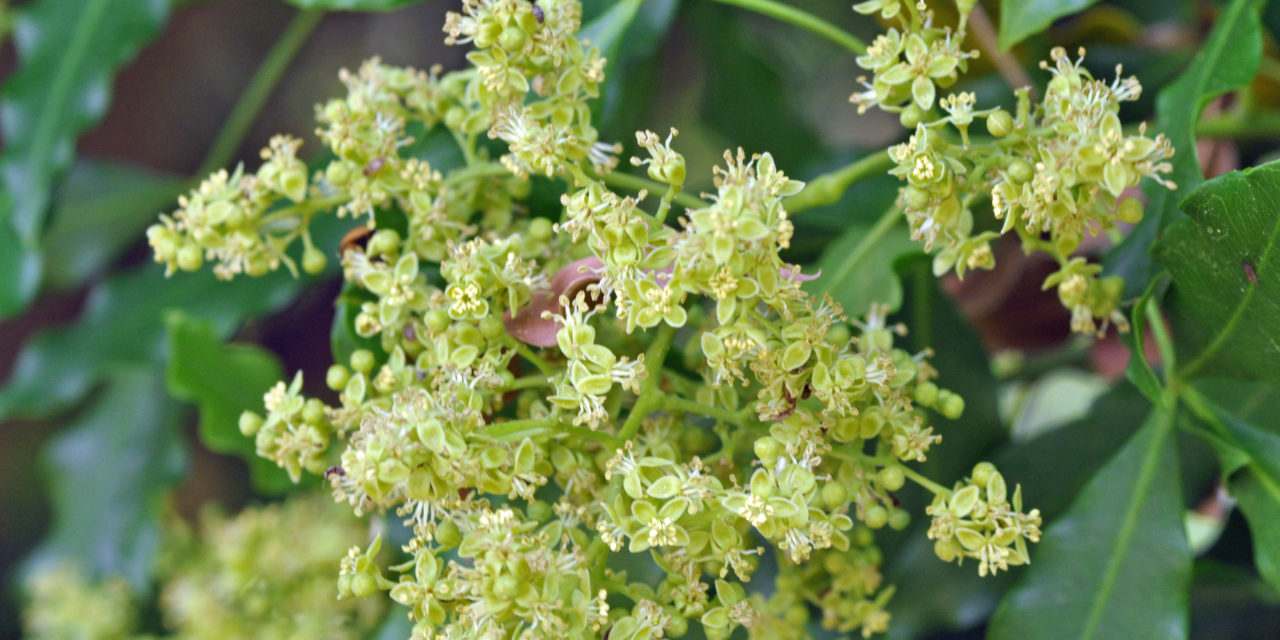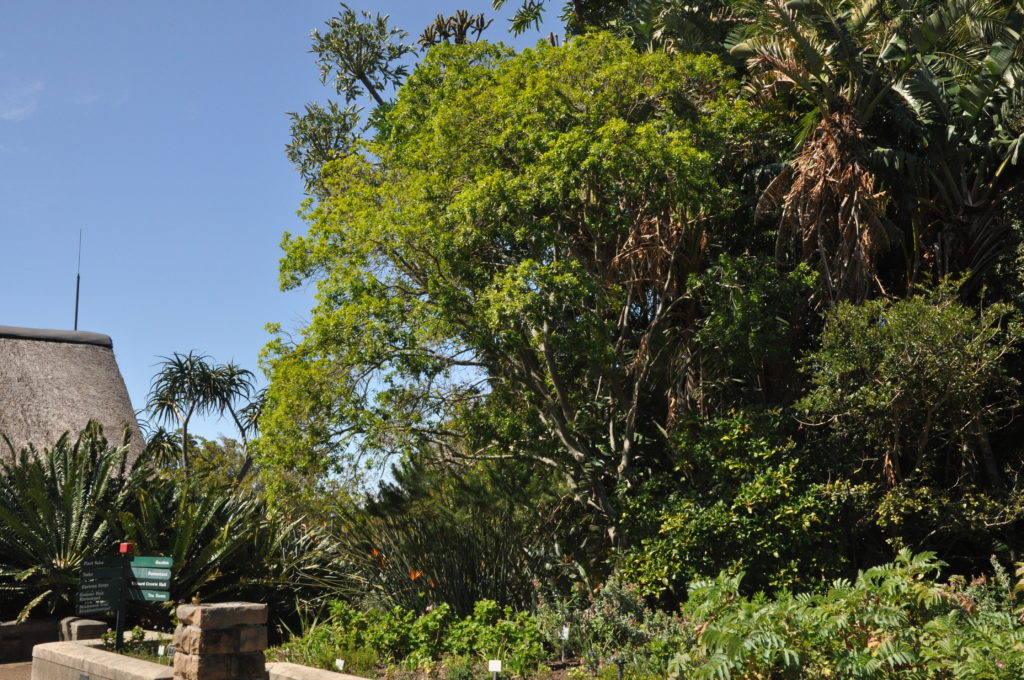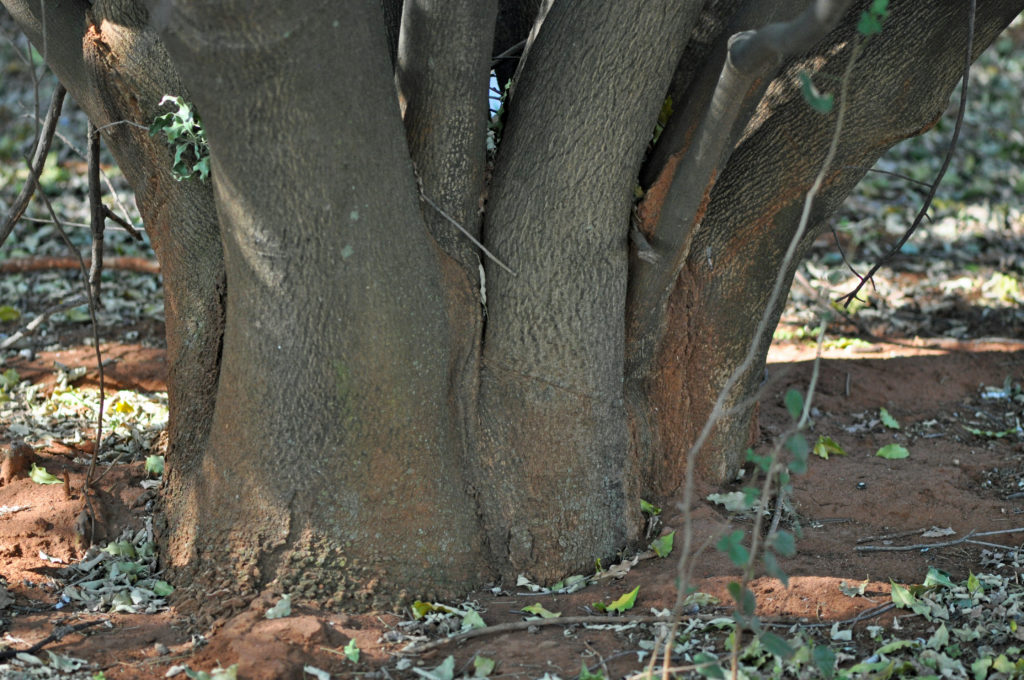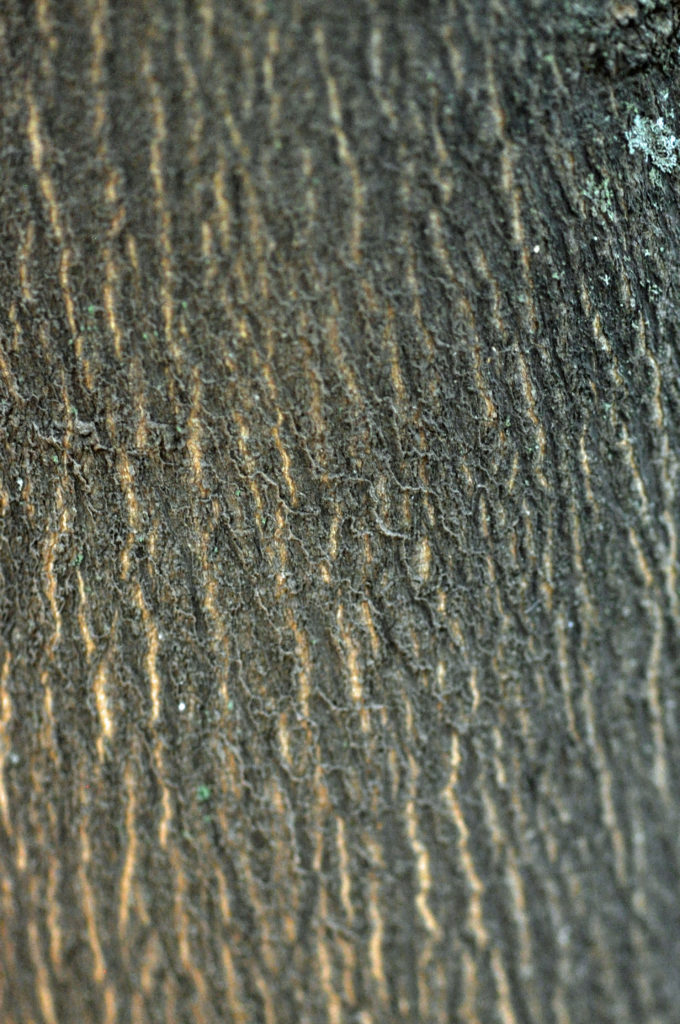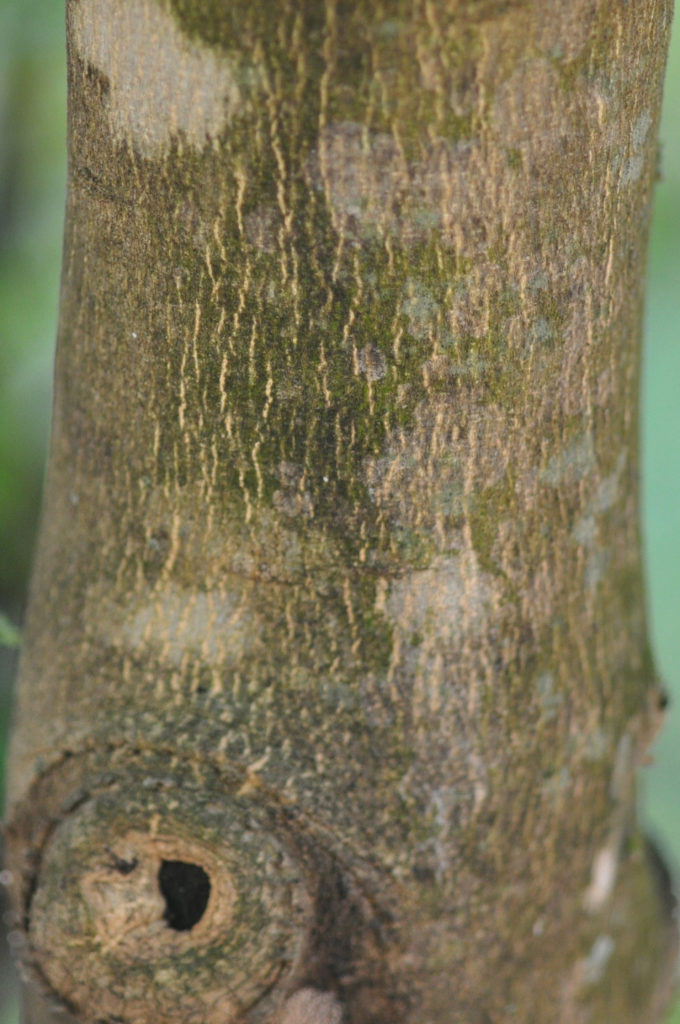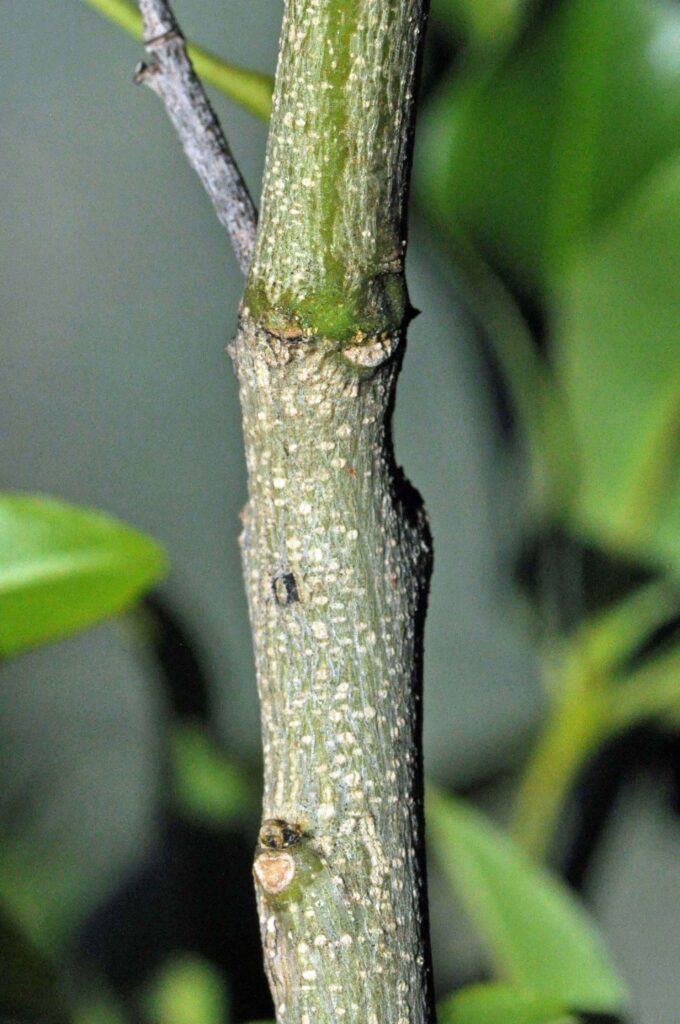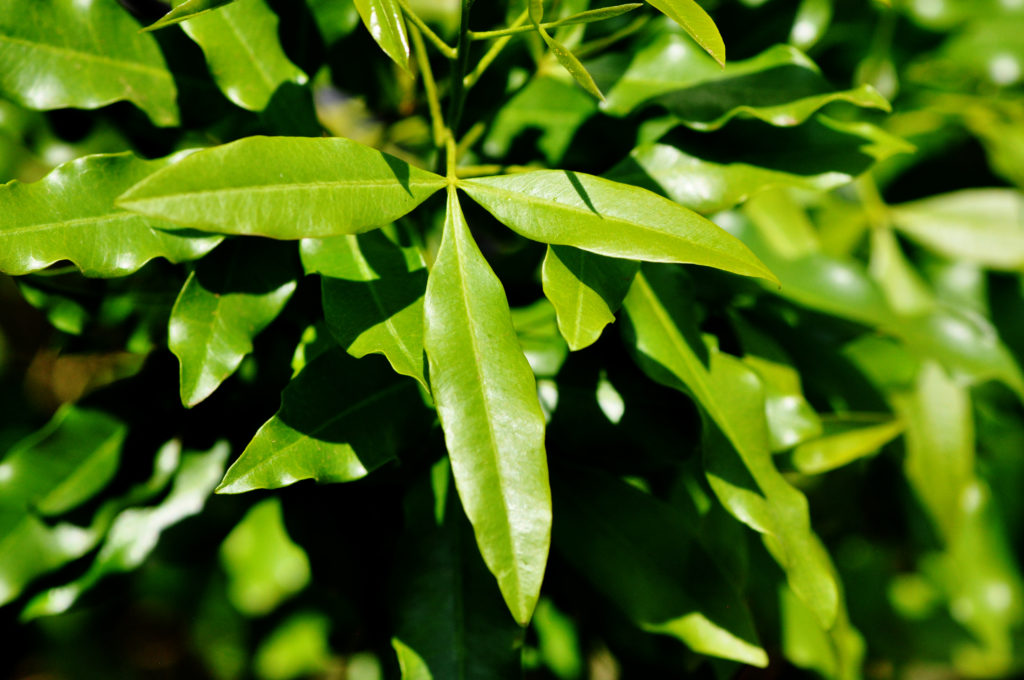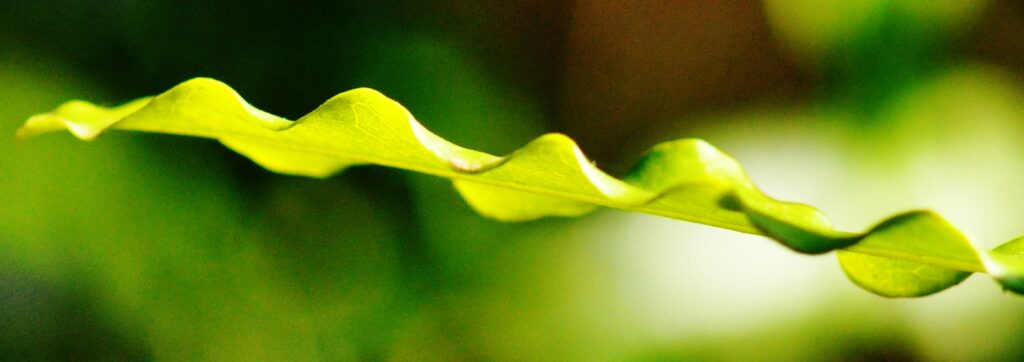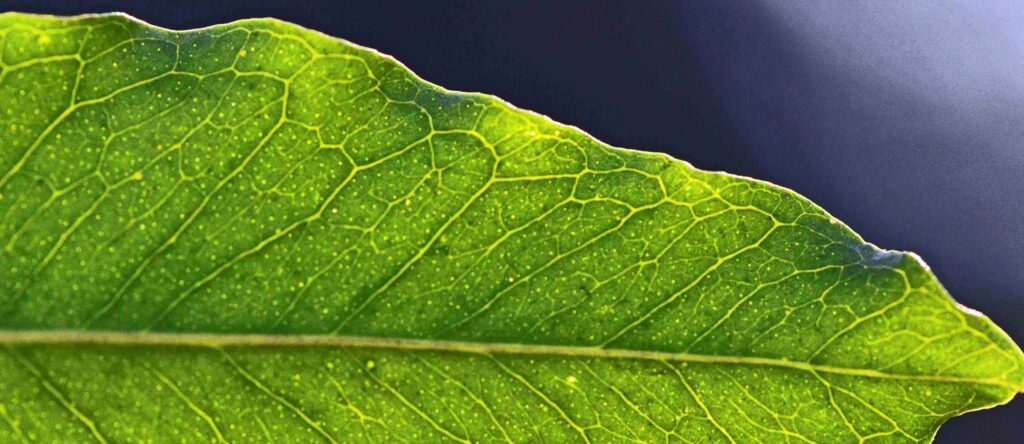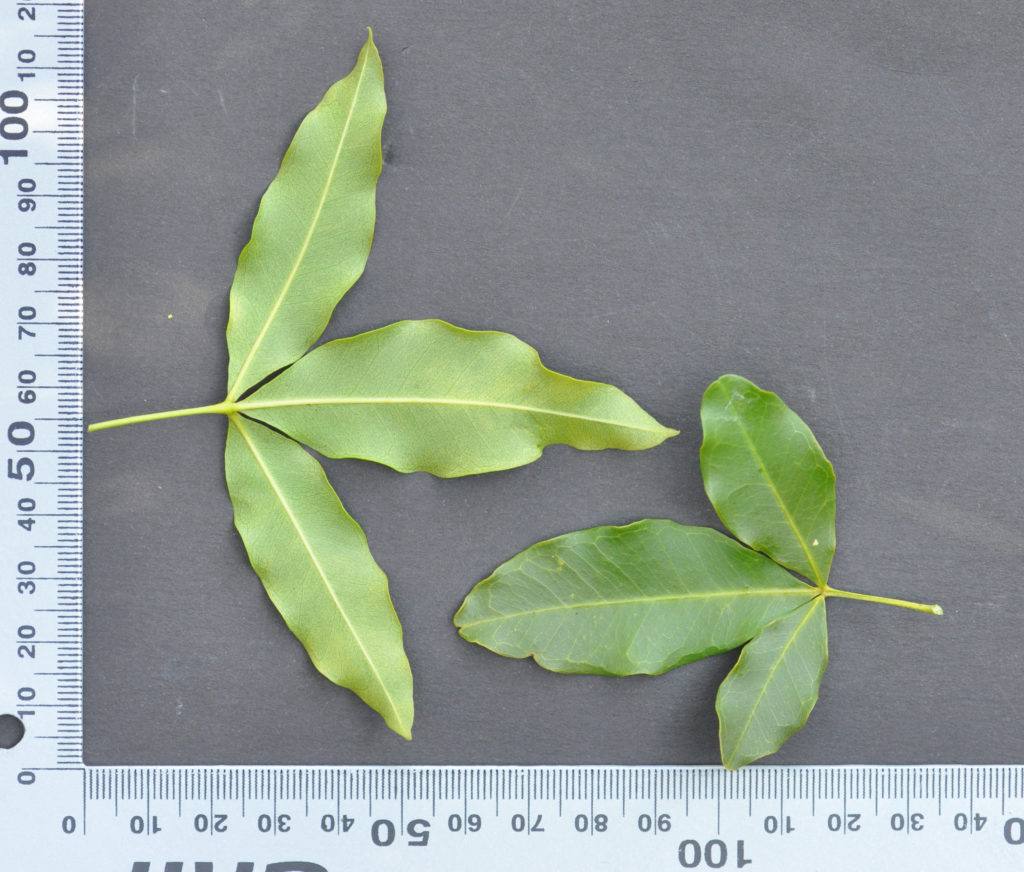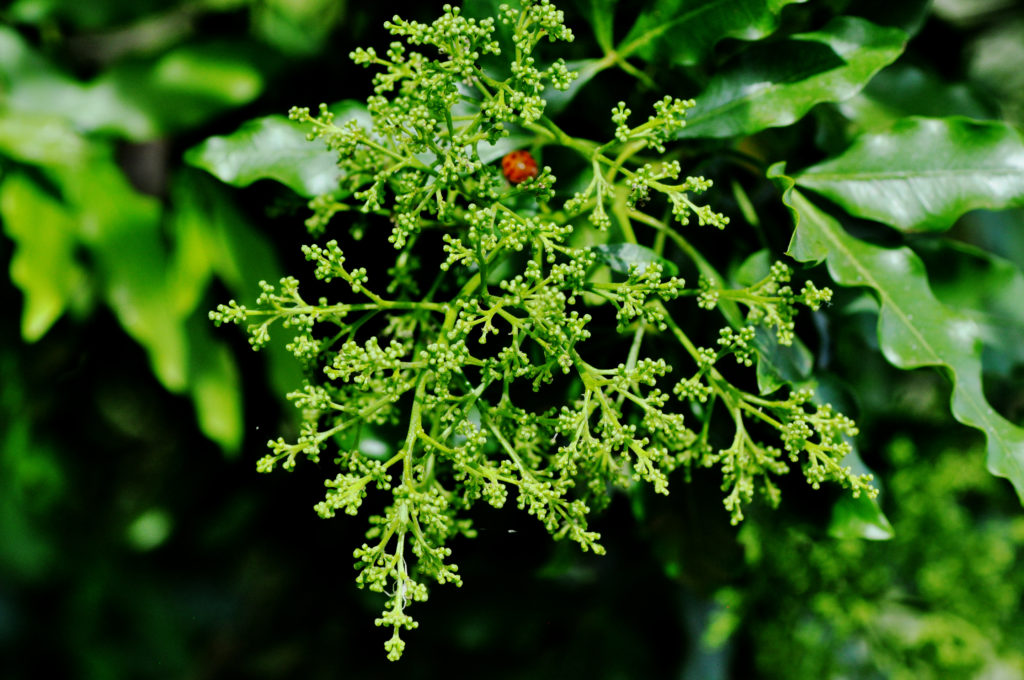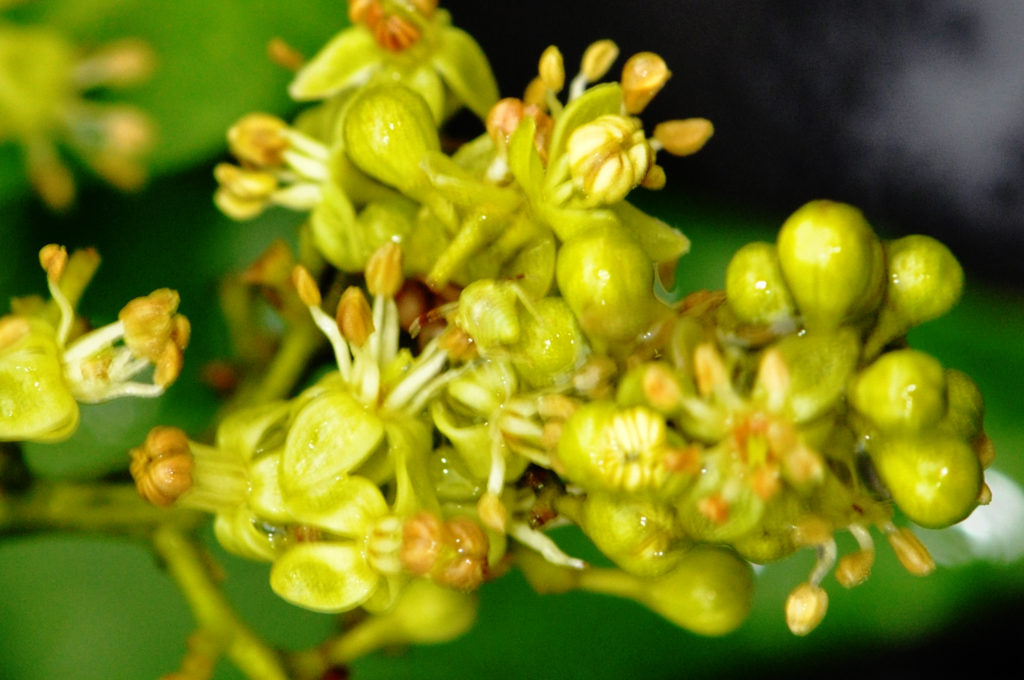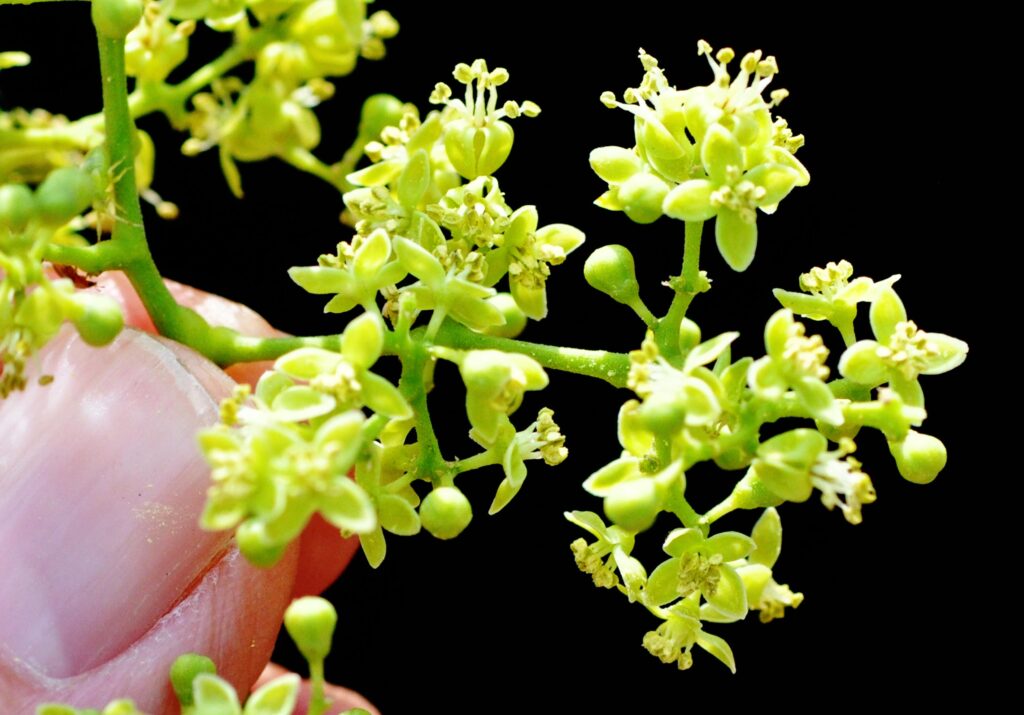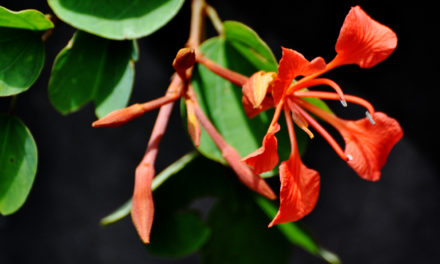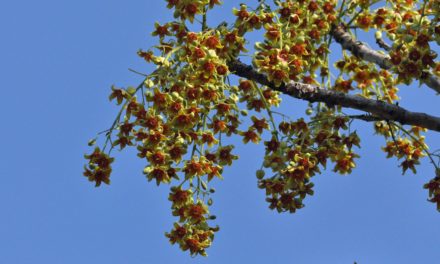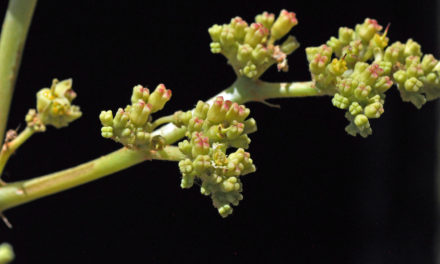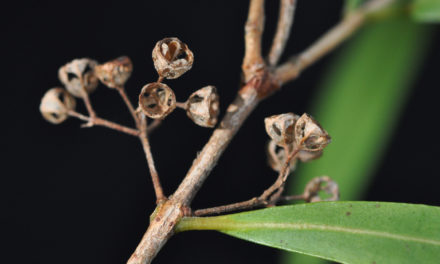General Info – summary
This unarmed dioecious evergreen Tree with an erect trunk, often has high up branches and is usually up to 20m high. The alternate trifoliate drooping Leaves have long grooved petioles, lack stipules and have gland dotted leaflets. Regular small star-shaped and 4-merous Flowers are in panicles. 8 anthers in males and females have a superior ovary. The small, 4-locular, lemon scented Fruit ripens to a black or purple.
Description
Vepris lanceolata
Previous Names: Toddalia lanceolate, Vepris undulata.
SA No. 261.
Common names. (Afr) Witysterhout. (Eng) White-ironwood. (isiXhosa) Ilatile-lokuqhumisa, Ubulawo, Umngumaswile, Umzane. (isiZulu) Isutha, Umzane, Umozane. (Setswana) Amotane. (Tshivenda) Muhondwa. (Xitsonga) Amotane.
Family: Rutaceae (Citrus family) has 160 genera and 2 000+ species. Leaves often have pellucid (clear, almost transparent in transmitted light) oil glands which are responsible for the aromatic smell. These gland dotted leaves are usually opposite and lack stipules. Most leaves are compound and lack stipules. The plants are usually monoecious. The regular Flowers are bractless, bisexual or unisexual. They have 4-5 Petals, which are usually free. The Stamens have anthers that are dorsifixed and 2-thecous (have 2 pollen sacs). Staminodes are often present. The Ovary usually has 5 carpels and the Style is simple. Fruit is variable. This family has 23 species in Africa. The Rutaceae in southern Africa are largely concentrated in the Western Cape. Indigenous genera with trees on this website include Calodendron, Ptaeroxylon, Vepris and Zanthoxylum.
Name derivation: Vepris – bramble / spiny shrub. However, local trees are unarmed. lanceolata – referring to the lance-shaped leaflets. There are about 7 species of the genus Vepris in southern Africa.
Conservation: National Status: L C (Least Concern). Assessment: 2005 (W. Foden and L. Potter). Bark eating porcupines may become a problem.
Tree
This unarmed Tree with a wide gently rounded crown, may reach a height of 30m in forests but it is usually up to 20m high (photo 448) and may be multi-stemmed (photo 41). On the dunes, it may be no more than a bush. The slender, straight and erect Trunk has a diameter of up to 1,5m. The grey, dark grey or purple-grey Bark may be longitudinally striated (photo 42). At the base of old trees, the bark may be yellow and crumbly. In forests, the surviving Branches occur high up. The smooth bark on the branches has visible Lenticels (usually raised corky oval or elongated area on the plant that allows the uncontrolled interchange of gases with the environment – photo 685.
- 448. 2018/09/16.. Kirstenbosch NBG. Photo: David Becking.
- 41. 2018/08/17. Pretoria NBG. Photo: David Becking.
- 42. 2018/08/17. Pretoria NBG. Photo: David Becking.
- 29. 2014/09/23. Walter Sisulu NBG. Photo: David Becking.
- 685. 2016/08/30. Walter Sisulu NBG. Photo: David Becking.
Leaves
This evergreen tree has hairless spreading Leaves that are alternatively arranged (photo 43) and trifoliate (compound leaf with 3 leaflets – photo 34). Each Leaflet is up to 13 x 3,5cm and the central leaflet is the longest. Occasionally 4 leaflets are present. The Petiole (leaf stalk) is up 5cm long (photo 314) and grooved above. The petiole is not winged. In SA, Vepris carringtoniana has winged petioles and occurs in Limpopo and Mpumalanga. Petiolules (leaflet stalks) are usually not distinctly visible. The slightly drooping leaflets are usually lance-shaped or elliptic to narrowly elliptic. The sharply (photo 314) to bluntly tapering Apex may even be rounded and the Base tapers. The rolled under Margin is entire (with a continuous margin, not in any way indented) and distinctly wavy (photo 30). The Blade is densely dotted with glands (photo 40) resulting in the leaves being lemon scented when crushed. These Veins loop together before reaching the margin (photo 40) are more visible using a hand lens and viewing the leaf against a strong light. Stipules (basal appendages of the petiole) are absent.
- 34. 2014/09/23. Walter Sisulu NBG. Photo: David Becking.
- 43. 2018/08/17. Pretoria NBG. Photo: David Becking.
- 30. 2014/09/23. Walter Sisulu NBG. Photo: David Becking.
- 40/ 2018/08/17. Pretoria NBG. Photo: David Becking.
- 314. 2014/06/24. Walter Sisulu NBG. Photo: David Becking.
Flowers
Details of the star-shaped, greenish yellow Flowers are inconspicuous (here a hand lens is essential) and actinomorphic (Regular, symmetrical. Flowers are vertically divisible into similar halves by more than 1 plane passing through the axis). Flowers occur at the end of branches in Panicles (indeterminate, branched inflorescence with stalked flowers) which are up to 12cm long (photo 197). The cup-shaped Calyx has 4 very small Sepals, and the four lobes are not joined at the base. The creamy-white, somewhat fleshy Corolla has 4 yellow to green Petals (photo 628) and is gamopetalous (has united or joined petals at least at the base, allowing the corolla to be removed as a single piece). This tree is dioecious (unisexual floral structures with male and female parts are on separate plants). In the Male Flower, buds are green and obovate (like an upside-down egg – photo 500). There are 8 Stamens which are attached to the base of the Disc (a more or less fleshy or elevated development of the receptacle). The stamens lack apical glands. The Filament of each stamen is white, and the 8 Anthers are initially yellowish and eventually turn brown (photo 628). The anthers open and release pollen through longitudinal slits. Pollen grains are just visible on the thumbnail (photo 500). This photo gives a visual idea of how small the flowers are. The ovary in the male flower is rudimentary. In the Female Flowers, there is a single Pistil (a unit of the Gynoecium, the female element of the flower, composed of the Ovary, Style and Stigma) and 8 rudimentary Staminodes (sterile stamens) are present. The Ovary is superior and has a short Style terminating in a single shield-shaped Stigma. (Oct-Mar).
- 197. 2017/10/07. Walter Sisulu NBG. Photo: David Becking.
- 628. 2014/11/11. Walter Sisulu NBG. Photo: David Becking.
- 500. 2015/10/20. Walter Sisulu NBG. Photo: David Becking.
Fruit
The small, fleshy and leathery Fruit is lemon-scented and up to 12 x 5mm (usually smaller). It is almost spherical to ellipsoidal, and 4-locular and 4 seeded. The gland-dotted fruit Matures to a dark purple or black. (Feb-Jul).
Distribution & Ecology
This plant may be a bush in dunes, or a tree adapted to a wide range of conditions, and it occurs in most South African forests. The best growing conditions occur in dry types of forests near the eastern and southern coast and inland to the midlands. Porcupines eat the Bark, and this is a problem because they can also ring it during the process causing the tree to die. Trees occur in the Western Cape, Eastern Cape, KwaZulu-Natal, Mpumalanga, Limpopo, northern Gauteng, and northern North West Provinces. Beyond South Africa they are present in Tanzania, Kenya, Reunion and Mauritius. This drought resistant tree will tolerate light frost. Bees feed on the flowers. Birds such as red-winged starlings and Black-eyed Bulbuls eat the Fruit and attracted insects. Butterfly larvae that feed on the Leaves include the green-banded swallowtail (Papillo nireus) that is common in southern, eastern and northern South Africa. This is the only large black butterfly with green or blue bands. The white-banded swallowtails (Papillio echerioides) occur in Sub-Saharan Africa and has a low fluttering flight. There larvae feed on young leaves. The Christmas butterfly or citrus swallowtail (Papillo demodocus demodocus) is common and widespread throughout South Africa especially wooded areas and gardens. There larvae feed on young leaves of this plant and other members of the Rutaceae family.
Ethnobotany
The strong fine, pale yellow to white and even-grained Wood is flexible, smooth, hard and elastic. Uses include making roof beams, tent hoops, hoe handles, spokes (each of the bars or wire rods connecting the centre of a wheel to its outer edge) and instrument handles. The branch ending Flowers attract many insects – which in turn attract birds. Leaves are used as a spice or pepper substitute. Cultivated plants may have galls on the Leaves caused by jumping Psyllid lice (insects) in the Psyllidae family. These lice feed on the phloem tubes (which conduct products of photosynthesis) in this specific host plant. Local medicine makes use of Roots. Planted seed require a reasonable water supply and roots are not very aggressive. Trees can be pruned and do well in containers.
References
Boon, R. 2010. Pooley’s Trees of eastern South Africa. Flora and Fauna Publications Trust, Durban.
Burrows, J.E., Burrows, S.M., Lotter, M.C. & Schmidt, E. 2018. Trees and Shrubs Mozambique. Publishing Print Matters (Pty) Ltd. Noordhoek, Cape Town.
Coates Palgrave, M. 2002. Keith Coates Palgrave Trees of Southern Africa, edn 3. Struik, Cape Town.
Foden, W. & Potter, L. 2005. Vepris lanceolata (Lam.) G.Don. National Assessment: Red List of South African Plants version. Accessed on 2024/03/28.
Ginn, P. J, McIlleron, W.G, & Mimstein, P. le S. 1991. The Complete Book of South African Birds. Struik, Cape Town/Singapore.
Lawrence, G. H. M, 1951. Taxonomy of Vascular Plants. The Macmillan Company, New York. Tenth Printing 1965.
Palmer, E. & Pitman, N. 1972. Trees of southern Africa. Balkema, Amsterdam, Cape Town.
Schmidt, S. Lotter, M. & McCleland, W. 2002. Trees and Shrubs of Mpumalanga and the Kruger National Park. Jacana, Johannesburg.
van Wyk, B. & van Wyk, P. 1997 Field guide to Trees of Southern Africa. Struik, Cape Town.
Woodhall, S. 2020. Field Guide to Butterflies of South Africa, edn 2. Donnelley, RR, China.
http://www.plantzafrica.com/planttuv/veprislan.htm
file:///C:/Users/Probook/AppData/Local/Microsoft/Windows/Temporary%20Internet%20Files/Content.IE5/K60TBBRU/Arbour_Week_and_Trees_of_the_Year_2014_editorial.pdf
http://www.florarsa.co.za/tree-year-2014.html
http://suntrees.co.za/2015/09/10/vepris-lanceolata-white-ironwood-wit-ysterhout/
https://en.wikipedia.org/wiki/Papilio_nireus
http://images.peabody.yale.edu/lepsoc/jls/1970s/1971/1971-25(4)271-Owen.pdf
http://posa.sanbi.org/flora/browse.php?src=SP

